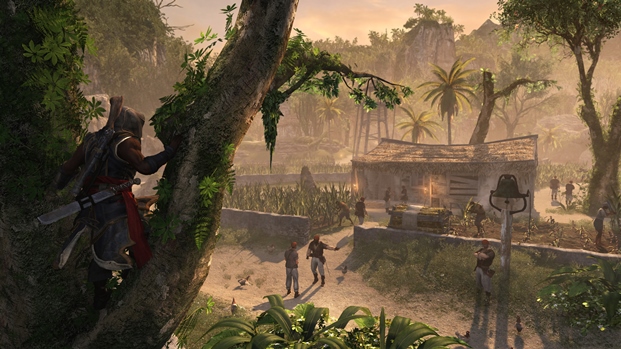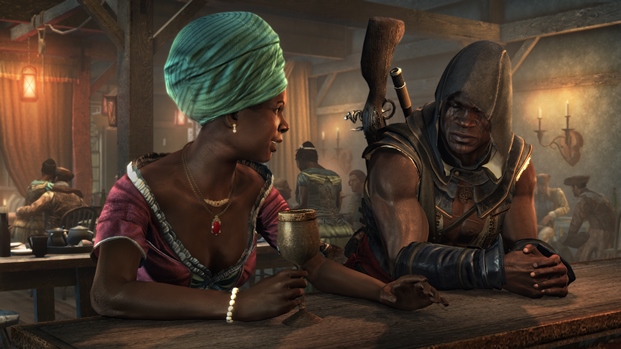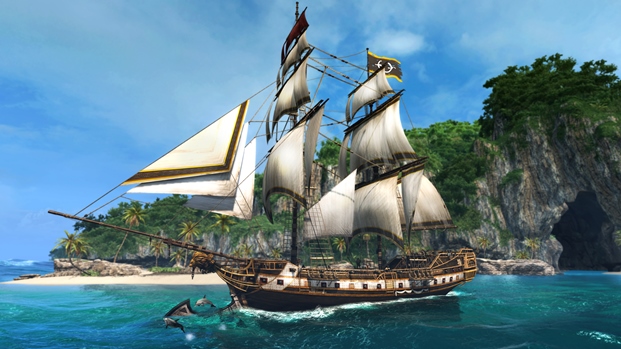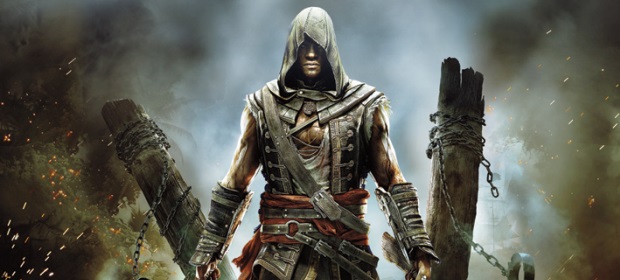There may be mild spoilers for Assassin’s Creed IV: Black Flag in the following DLC review. Read no further if you’re still to learn the fate of Edward Kenway and the Jackdaw.
Assassin’s Creed games are like Bond movies. No sooner has one been released, than the fans start trying to predict the events of the next one. The moment Edward Kenway first set sail across the Caribbean in Black Flag, the internet was abuzz with rumours and guesswork, as eagle-eyed players sought clues as to the next game – often where there were no clues to be found.
But Ubisoft are a clever outfit, and they reveal what they want to reveal when they feel it’s appropriate. Wisely, the French developers have been known to throw red herrings into the Assassin’s Creed mix from time to time in the form of Easter Eggs that may or may not pertain to a more connected universe between AC, Far Cry and next year’s hotly-anticipated Watch_Dogs. With the Assassin’s Creed III: The Tyranny of King Washington DLC they went wildly off the reservation with a hit-and-miss alternate reality style side-story that didn’t really bring anything to the franchise. It’s all incredibly confusing to people, especially when you factor in the very meta sub-plot of Assassin’s Creed IV.

So it’s a little relieving that it would appear, on the surface at least, that Ubisoft are keeping things simpler with the Freedom Cry DLC. While Kenway’s story reached its own satisfying conclusion, it did leave a gulf of at least ten to twenty years between the end-game and the epilogue – and this is where the first slice of DLC slots neatly into place. Abandoning Kenway for a new protagonist in the form of Adéwalé, the Jackdaw’s first mate and Quartermaster for much of Black Flag, Freedom Cry is unconstrained by any limitations that might have been imposed by the epilogue. An Assassin in his own right, Adé is more forthright and honour-bound than Kenway ever was, but perhaps even more deadly, as we join him after 15 years ‘neath the hood.
The story of Freedom Cry begins similarly to Black Flag: washed up after a ship-to-ship battle goes awry, Adé soon finds himself working for the mysterious Bastienne in the business of freeing slaves. Immediately, you feel more “behind” his cause than you did Kenway’s – even though his primary concern is returning to the Brotherhood. While the issue of racism is one that most games won’t touch, Freedom Cry’s approach is so ham-fisted and Hollywood-like that it doesn’t really matter. Slavers are bad, slaves are good and your job is to free them. While such simple truths are universal – and therefore work well as they are – it would have been nice to see a little more depth written in, rather than the slavery existing simply to give you a reason to complete the (admittedly great) new Liberation objectives.

The power behind all of Adé’s upgrades and progressions is the emancipation of the shackled. Freeing slaves will see them join you or your cause, adding to your crew and affording you upgrades for your ammo pouches and weapons at Harbourmaster stores or Maroon traders you can find dotted about the landscape. Sometimes you’ll see a slave fleeing his master, or a group being escorted through town, locked in a cage or being auctioned on a raised dais. Freeing them is your ticket to success, and you can’t deny the warm fuzzy feeling you get from killing slavers. It’s not the same as merely running soldiers through in order to clear the way; silently taking out twenty plantation overseers while keeping the forty resident slaves alive feels like a reward in of itself.
And Adé is a brutal type, too. Although when sprinting he moves the same as all the Assassins, in combat he’s a different beast. He lacks the finesse of Ezio or even Kenway, instead using a rusty machete and multi-killing blunderbuss (think an 18th century 12-guage) to hack and smash his way through enemies. Wrist-blades, rope darts and blowpipe come as standard, of course, but with Adé they seem to be secondary concerns to simply mutilating everyone in his path, breaking necks and slitting throats left, right and centre. Clearing plantations and liberating slaves sees you clear of your first few objectives, until it’s time to make a daring raid on your very own vessel, the Experto Crede. Unlike the Jackdaw, the Crede comes equipped with decent armour and guns right from the start – although you can upgrade her further later on.

The thing about Freedom Cry is that everything comes kind of easy, and the 2 to 4 hour runtime of the main story could have been extended quite easily if Ubisoft had required more grinding of us, as they did in Black Flag. As it stands, they got the balance slightly wrong again, this time making it a little too easy to get ahead – especially once you realise that the key to success almost every time is killing your enemies as fast as possible, and hang the stealth. You even use firecrackers to distract guards – Altair would be turning in his grave. That being said, it does have stand-out moments, the aforementioned misappropriation of the Crede being one of them.
Although much was made of the new areas, very little actually looks to have changed in Freedom Cry. Being a French settlement, Port au Prince has a style of its own, but despite some graphical tweaks there isn’t much to separate it from Havana or Nassau once you delve beneath the surface. In fact, a lot of it looks exactly like the plantations in the main game, all thatched huts and plenty of greenery to stalk from. In almost all ways, Freedom Cry looks and plays like Black Flag, and Ubisoft still don’t do enough to differentiate between their Assassin’s beyond the physical appearance and, of course, weaponry. There are no improvements to the visuals, and on last-gen consoles there’s still a minor problem with framerate now and then, and occasional pop-up textures. Also, I had to restart a tailing mission twice because it simply refused to continue for no reason whatsoever when the target appeared to have a quiet breakdown and just stand there. At present, I’m not sure if this is a bug or an issue exclusive to me.

VERDICT: Freedom Cry is a fine side-story, fleshing out the character of Adéwalé and introducing a new settlement, new missions, new ways to kill and a new enemy to rail against. However, it feels very much like Black Flag – but without the presence of Edward Kenway as a protagonist. Although Adé’s quest is more honourable and selfless than his former Captain’s, even his gruff way with words isn’t quite enough to sell him. There’s something not quite there that should be, though it’s difficult to pin down what that something actually is. It’s probably just that he lacks the Welsh charm and Heath Ledger looks that made Kenway so easy to like despite his roguish ways. It’s also a little too easy and lacks a wealth of side-missions, so you may find yourself inclined to simply tear through it and wonder where the hell it went when it ends.
All things considered, if you want more Black Flag, or you need more Adéwalé in your life, grab Freedom Cry as soon as you can, as it absolutely delivers. If, however, you were after some DLC with a real bearing on the story and franchise as it exists already, you might be slightly disappointed. Beyond appearances, there’s not much that’s new or any more interesting than we’ve seen before – although Freedom Cry does hint at greater things to come. Recommended, but not truly essential.

VERY GOOD. An 8/10 is only awarded to a game we consider truly worthy of your hard-earned cash. This game is only held back by a smattering of minor or middling issues and comes highly recommended.
Review code provided by publisher.





